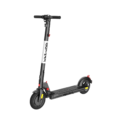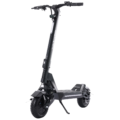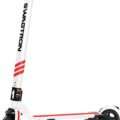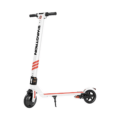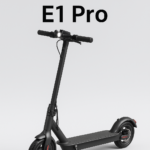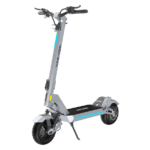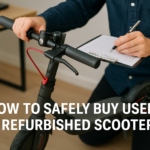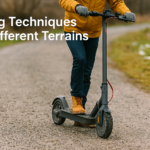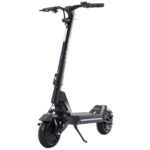- Home
- Scooters
- Electric Scooters
- Gotrax APEX MAX
Gotrax APEX MAX


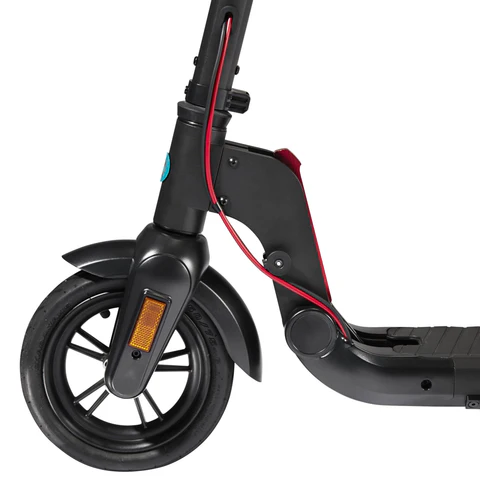
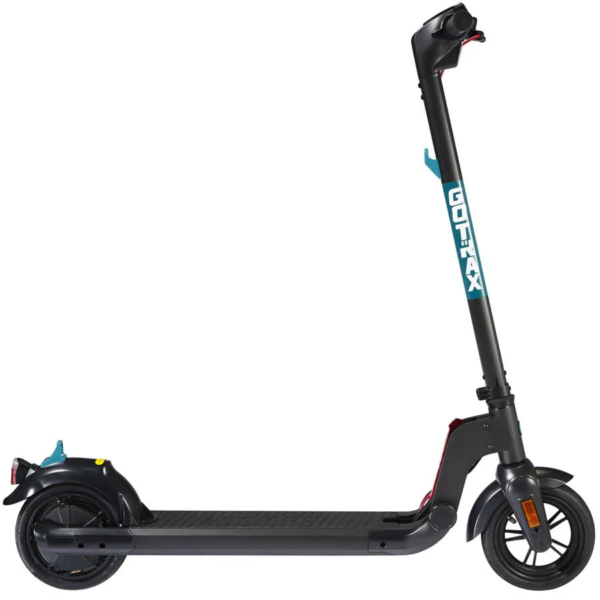
- Battery Range: 18 miles (~29 km)
- Top Speed: ~18 mph (~29 km/h)
- Motor Power: 350 W rated
- Weight Capacity: 120 kg (264 lb)
- Charging Time: ~4–5 hours
- Scooter Weight & Portability: ~14.5 kg (32.1 lb)
PROS
- Rear suspension transforms ride comfort
- Extended 7.8 Ah battery powers real-world 15–18 mi range
- Responsive braking system keeps you safe
- Simplified ride modes and cruise control
- UL safety-certified and durable build
CONS
- Edges into heavier territory
- No smart-device connectivity
- Pneumatic tires may need periodic upkeep
- Limited on steep inclines

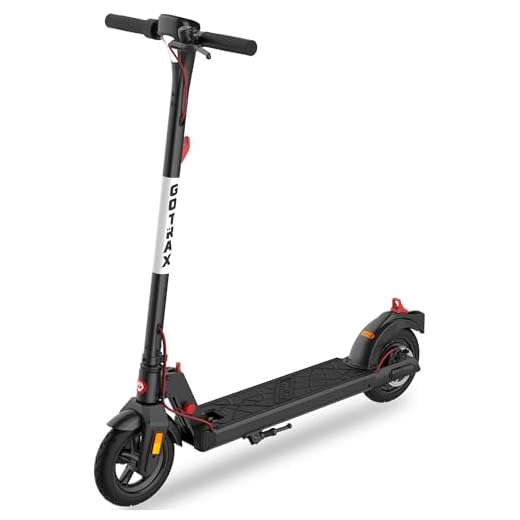
Gotrax APEX MAX Overview
A practical upgrade for everyday riders
The Gotrax APEX MAX aims squarely at commuters who want a little more comfort and distance than true entry-level scooters, yet still value a simple, no-fuss setup. It sits above the APEX XL in Gotrax’s line, and you can feel that step up in the first few minutes of riding. The motor pulls with more intent, the deck feels calmer over rough patches, and the rear suspension takes the edge off daily terrain. Because the design stays light and compact, you still get easy storage and straightforward handling. In short, it’s built for real streets, real errands, and real commutes—without pushing you into premium price territory.
The positioning makes sense. Many riders start on budget models, learn their routes, and then want more range and comfort. The APEX MAX answers that exact need. It adds battery capacity and damping where it counts, while keeping controls familiar and maintenance light. As a result, it’s a natural “second scooter” for people who outgrow the basics, and it’s also a smart “first scooter” for anyone who knows they’ll ride daily.
Motor feel, acceleration, and speed control
Under the deck, the APEX MAX uses a 350 W rated hub motor with enough headroom to feel lively from a stop. Off the line, power comes on smoothly, so you don’t get an abrupt surge that unsettles your balance. As you roll past walking pace, torque stays steady. Therefore, weaving through bike-lane traffic feels predictable, and merging from a side street never feels rushed.
Top speed hovers around the city-friendly mark—quick enough to keep pace with cyclists and the general flow, yet not so fast that you feel on edge. Moreover, the two speed modes help match conditions. Eco gives gentler throttle and stretches range on flat paths, while the faster mode unlocks the motor’s punch for open stretches or light headwinds. Because the throttle mapping is linear, you can “feather” speed with small finger inputs instead of jerky on/off shifts.
Cornering confidence comes from a combination of deck height, weight distribution, and tire footprint. The scooter tracks neutrally into turns, and it stands up cleanly as you exit. In addition, the rear suspension absorbs the mid-corner chatter that often causes nervous corrections on rigid scooters.
Range that fits real commutes
Range claims mean little without context, so let’s frame the APEX MAX in real life. On mixed routes—some stops, some bike-lane cruising, a few gentle inclines—you can expect mid-teens to high-teens miles on a full charge, depending on rider weight, wind, and temperature. On flatter routes in Eco mode, you’ll naturally see more. On hilly, fast routes with colder weather, you’ll see less. Even so, the battery gives enough headroom for most round-trip commutes, plus a detour for groceries.
Because the pack uses a common 36 V architecture, the power delivery feels familiar to many riders. Voltage sag under load stays moderate, so speed doesn’t collapse the moment you meet a small incline. Moreover, the controller meters current responsibly, which helps the pack maintain healthy temperatures and extends its service life.
Want to stretch range further? Three habits help: keep tires at proper pressure, ride in the calmer mode whenever the path allows, and avoid full-throttle launches when they’re not needed. These small choices add up across a week of commuting.
Charging workflow and battery care
Charging takes roughly a typical evening—think four to five hours from low to full. Consequently, the simplest routine is “plug in when you get home, ride in the morning.” If you work near an outlet, topping up at the office also works well. For battery health, store and charge at room temperature when you can. Although the pack tolerates cool garages, extreme heat or deep cold shortens both range and longevity.
In addition, avoid leaving the battery at 0% for days. Lithium-ion cells prefer the middle. If you won’t ride for a week, park it at roughly half charge and disconnect the charger. These basic practices keep performance consistent month after month.
Braking and safety confidence
Stopping systems often define how “safe” a scooter feels, and the APEX MAX gets this right. The front electromagnetic brake scrubs speed smoothly with no sudden bite, while the rear drum brake adds firm, mechanical stopping power when you squeeze harder. Because both systems work together, you can modulate braking from gentle roll-offs to decisive stops without drama.
Surface conditions matter, of course. On dusty or wet pavement, begin with front electronic braking to settle weight, then add rear brake pressure. This sequence keeps the chassis stable and the rear end hooked up. Furthermore, the rear suspension helps the tire stay in contact with the road during hard braking, improving control when you really need it.
Lighting also supports safe riding after dark. A bright forward LED illuminates your path, and the rear light helps drivers read your position. Side reflectors add extra angles of visibility. For riders who often return home at dusk, these details make a clear difference.
Suspension that takes the edge off
If you’ve only ridden rigid scooters, the APEX MAX’s rear suspension will feel like a small revelation. It won’t erase every pothole, yet it noticeably reduces chatter over cracked asphalt, joints, and tile transitions. Therefore, your knees and ankles do less work, and your hands don’t buzz after a long path.
Pair that with air-filled tires and you get a two-layer comfort system: air volume smooths the first hit, and the springs calm the follow-up bounce. Moreover, because the damping is tuned for commuting rather than jumping, the scooter stays composed if you hit a series of ripples in quick succession. You roll through instead of pogo-sticking across.
Handling, stability, and rider posture
Comfort doesn’t help if a scooter feels vague. Thankfully, the MAX’s chassis geometry encourages stable straight-line tracking. On long bike-lane stretches you can relax your shoulders, glance at mirrors or cross-traffic, and hold line without micro-corrections. In addition, the deck’s grip texture keeps shoes planted even if your route includes a damp patch or two.
Posture matters on longer rides. A slight bend in the knees, hips relaxed, and elbows soft turns rough pavement into a mild hum instead of a series of thumps. Because the bar height is set for average adults, most riders find a neutral stance within minutes. If you’re taller, stagger your feet—front foot angled forward, rear foot across the deck—to gain a few centimeters of effective handlebar reach.
Tires, traction, and pressure tips
The 8.5″ pneumatic tires weigh more than honeycomb solids, yet they earn their spot here. They grip better in the wet, they corner more naturally, and they let the suspension do real work. Keep them inflated to the maker’s recommended pressure and check weekly; even a small drop reduces range and increases pinch-flat risk. Conversely, over-inflation hurts traction and ride comfort, so resist the urge to pump until rock-hard.
Carry a compact hand pump and a patch kit in your bag or at home. Although punctures are uncommon with careful route choices, being prepared turns an annoyance into a 10-minute fix.
Portability and folding in daily life
At around 32 lb, the APEX MAX isn’t featherlight, but you can still carry it for short hops—up porch steps, onto a train, or through a hallway. The single-latch fold drops the stem quickly and locks cleanly. Because the folded package stays compact, it slides behind a door, under a desk, or into a small trunk without fuss.
For mixed-mode commuters, this flexibility is crucial. You might ride to a transit stop in the morning, fold for the train, then unfold and glide the last kilometer to the office. Moreover, the latch feels secure—no rattles when locked upright—so steering stays precise.
Build quality and long-term durability
The APEX MAX relies on an aluminum alloy frame that balances rigidity with weight. Welds are tidy, panels fit snugly, and bolts sit protected from direct spray. As you add miles, you’ll notice the frame keeps its “tight” feel if you handle routine checks. Tighten the stem clamp if needed, wipe sand from moving parts, and keep the brake linkage free of grit.
Because the scooter uses common components (tires, tubes, brake shoes), seasonal upkeep stays affordable. You won’t need specialty tools beyond basic hex keys and a tire lever. Consequently, ownership costs remain low compared to many higher-end models.
Weather, water resistance, and storage
The IPX4 splash rating means the scooter tolerates drizzle and the occasional shallow puddle. Even so, aim to avoid heavy rain when possible. Water increases stopping distance, reduces traction, and stresses bearings and electronics. If you do get caught out, dry the scooter afterward: wipe the deck, stand it upright, and let air move around the charge port before plugging in.
Storage matters, too. Garages and closets are ideal; trunk storage works if the day won’t exceed summer temperatures. In winter, bring the scooter or battery indoors before charging. Cold cells sip energy slowly and charge less efficiently.
Display, controls, and cruise control
The LED dashboard shows speed, battery bars, and mode at a glance. It stays readable in sunlight, which helps when you ride at midday. Buttons have a clear click, so you don’t fumble when toggling lights or modes at a stoplight. Because the interface is minimal, you learn it once and stop thinking about it.
Cruise control earns special praise on this model. On long, straight paths, hold a steady throttle for a few seconds and the scooter locks your pace. Tap the brake or twist the throttle to exit. As a result, hand fatigue drops on 5–10 km runs, and you can focus on surface changes and traffic rather than micro-managing speed.
Maintenance schedule that actually works
A simple upkeep rhythm keeps the APEX MAX feeling new:
- Weekly: check tire pressure; quick visual scan for debris in the brakes; wipe dust from the deck and fork.
- Monthly: check stem clamp tension; inspect brake actuation and lever travel; confirm bolts on the folding hinge stay snug.
- Quarterly: true the rear brake if needed; replace worn brake shoes; assess tire tread and sidewalls.
Because these tasks are short, you can fold them into weekend routines. Moreover, consistent care pays off in silent rides and reliable stopping.
Real-world scenarios you’ll actually face
Commute with a mild climb: Switch to the faster mode for the incline, then back to Eco on the plateau. You’ll gain time without burning the pack on the easy parts.
Grocery run: Use cruise on the lane to the store, fold the scooter into the cart bay or lock it nearby, and use regenerative braking on the way home to save the pads.
Campus life: Glide between classes, fold for crowded hallways, and charge at the dorm. The simple controls mean first-time riders adapt quickly.
Weekend loops: Choose smoother greenways and keep a spare tube at home. Because the ride is calmer than rigid scooters, you’ll enjoy longer outings without sore hands.
Comparison inside the Gotrax family
If you’re stepping up from a basic commuter, you’ll notice the MAX’s extra comfort immediately. The APEX XL is lighter and cheaper, but the MAX’s rear suspension and larger battery deliver a calmer, longer ride. Likewise, the MAX sits above ultra-budget models in refinement, yet it keeps their simple charm.
Curious how a different budget model stacks up on weight and handling? See our Gotrax GXL V2 Specifications for a close, lighter sibling that many riders consider as a starter option. Comparing them side by side clarifies whether you value comfort and range (MAX) or pure portability (GXL V2).
Value and total cost of ownership
Upfront price matters, but so does lifetime cost. The APEX MAX scores well here. Tires and tubes cost little to replace. Brake parts are inexpensive. Electricity for weekly charging barely shows up on a utility bill. Meanwhile, the sturdier frame and calmer ride help you keep the scooter longer before feeling the itch to upgrade again.
Furthermore, the value equation improves if the scooter replaces rideshare trips or short car errands. Parking, fuel, and time often tip in the MAX’s favor for city distances. Even two or three avoided rideshare trips per week add up across a year.
Limitations and simple workarounds
No scooter excels at everything. The MAX’s weight, while manageable, isn’t ideal for carrying up several flights daily. If that’s your routine, store it at ground level or choose a lighter model for the carry portion. Also, pneumatic tires ride beautifully but may need patches. Keep a repair kit at home, and you’ll be back on the path fast.
Hills also set limits. Moderate slopes are fine; steep grades will slow the scooter, especially with heavier riders. Approach hills with momentum, let the motor settle into a steady pull, and accept a slightly lower pace instead of demanding full speed.
Who benefits most—and who might not
Best for: urban commuters, students, and errand-runners who ride most days and want comfort plus simplicity. If you want a calm chassis, real brakes, and a usable range without a premium price, this is your lane.
Maybe not for: riders who must carry a scooter up many stairs every day; thrill-seekers chasing 30+ mph; or anyone who needs 30+ miles of range in a single go.
That said, many riders find the MAX hits the goldilocks zone: light enough to live with, strong enough to rely on, and refined enough to ride daily.
Setup, onboarding, and first-week tips
Unbox, attach the handlebar with the included screws, and check bolt torque on the stem latch. Inflate the tires to spec, power on, and cycle the lights and modes to learn the button logic. On your first rides, use Eco and practice gentle braking in a quiet lot. After a few kilometers, test the faster mode on a straight bike path. In addition, try cruise control so it becomes second nature.
During the first week, listen for odd sounds and re-check stem clamp tension. Small adjustments early often prevent larger ones later. Once things bed in, you’ll settle into the weekly checks noted above.
Final verdict
The Gotrax APEX MAX brings real comfort and range to the budget-friendly commuter class. It adds rear suspension where it matters, pairs it with air tires, and keeps controls clean and simple. The braking system inspires trust, the chassis tracks straight, and the battery supports practical round-trips with room for detours. Because it avoids gimmicks, you can master it fast and focus on the road—not a screen.
If you want a scooter that feels a notch calmer and more capable than basic models, yet still folds fast and stores small, the APEX MAX fits. It won’t chase high-speed thrills, and it won’t carry you up mountains, but it will handle the daily grind with ease—and it will do it with a smooth ride that invites you to take the long way home.
Looking for other budget options to round out your research? Browse our 5 Best Electric Scooters Under $500 in 2025 for more ideas in the same price lane.
Specifications
General
| Model The Model specifies the exact version or name of the scooter. It helps identify its unique design, features, and specifications within the manufacturer’s product line. Knowing the model makes it easier to compare options, find compatible accessories, or look up support information. | APEX MAX |
| Brand The Brand identifies the manufacturer or company that designs and produces the scooter. A trusted brand is a sign of quality, reliability, and good customer support. Well-known brands often have higher standards for safety, performance, and after-sales service, giving you more confidence in your purchase. | Gotrax |
| Release Date The Release Date indicates when the scooter model was officially launched on the market. This helps you know how current the design, technology, and features are. A newer release date often means updated components, improved performance, and the latest safety or smart features. | 01 May 2023 |
| Recommended Age Recommended Age indicates the minimum age range that the scooter is designed for, based on safety, size, and ease of use. Following the recommended age helps ensure that riders can handle the scooter’s speed, weight, and controls comfortably and safely. Always check local laws and use protective gear, especially for younger riders. | 16+ years |
Performance & Power
| Motor Power (Wattage) What it means: The motor power, measured in watts (W), shows how strong the scooter’s electric motor is. Why it matters: Higher wattage usually means better acceleration, more torque, and improved performance on hills or rough terrain. For example, a 250W motor is good for flat city roads and light riders, while a 500W or 1000W motor provides more power for faster speeds or climbing steep inclines. | 350 W rated, up to 500 W peak |
| Top Speed The Top Speed indicates the maximum speed that the scooter can reach under optimal conditions. It’s usually measured on level ground with a fully charged battery and an average rider weight. A higher top speed allows you to travel longer distances faster, but always ensure you ride within legal speed limits and your personal comfort zone for safety. | ~18 mph (~29 km/h) |
| Battery Capacity Battery Capacity refers to the total amount of energy the scooter’s battery can store, usually measured in ampere-hours (Ah) or watt-hours (Wh). A higher battery capacity means you can ride longer distances on a single charge, reducing the need for frequent recharging. Keep in mind that actual range can vary depending on rider weight, terrain, speed, and weather conditions. | 36 V, 7.8 Ah (~280.8 Wh) |
| Estimated Range per Charge The Estimated Range per Charge indicates the average distance the scooter can travel on a single full battery charge. This range is calculated under optimal conditions, such as flat terrain, moderate speed, and average rider weight. Real-world range may vary depending on riding style, terrain, weather, and load. A longer range means fewer recharges and greater freedom for longer trips. | Up to 18 miles (~29 km) |
| Hill Climb Ability Hill Climb Ability describes the maximum incline or slope that the scooter can handle while maintaining stable performance. It’s typically expressed as a percentage or in degrees. A higher hill climb rating means the scooter can tackle steeper hills without losing too much speed or power. Actual climbing performance may vary based on rider weight, battery charge, and terrain conditions. | Moderate, suitable for urban slopes |
| Drive System The Drive System refers to how power from the motor is delivered to the wheels. Electric scooters typically use either a hub motor (directly integrated into the wheel) or a chain/belt drive system. A high-quality drive system ensures smooth acceleration, efficient power transfer, and low maintenance. The choice of drive system affects performance, noise level, and overall ride experience. | Front-wheel hub motor |
Charging & Electrical
| Charging Time Charging Time indicates how long it takes to fully recharge the scooter’s battery from empty to 100% using the standard charger provided. Faster charging means less downtime and more time on the road. Actual charging time may vary slightly depending on battery capacity, charger output, and environmental conditions. | ~4–5 hours |
| Battery Type Battery Type refers to the specific technology used in the scooter’s battery, which affects performance, lifespan, weight, and charging time. Most modern electric scooters use high-quality lithium-ion (Li-ion) batteries because they offer a good balance of energy density, durability, and low maintenance. A reliable battery type ensures consistent power delivery and longer riding ranges. | Lithium-ion with Smart BMS |
| Removable Battery A Removable Battery means the battery pack can be easily detached from the scooter for convenient charging and replacement. This feature allows you to charge the battery separately, swap it with a spare for extended range, or securely store it indoors in extreme weather. Removable batteries add flexibility and make it easier to keep your scooter powered up wherever you are. | No |
| Regenerative Braking Regenerative Braking is an energy-saving feature that converts some of the energy normally lost during braking back into battery power. When you slow down or brake, the motor works in reverse to generate electricity, which helps extend the scooter’s range and improves overall efficiency. This system also reduces wear on traditional brake components, leading to lower maintenance over time. | Yes |
| Lighting Lighting refers to the built-in front and rear lights that enhance visibility and safety when riding in low-light conditions or at night. Good lighting helps you see the road ahead and ensures that other road users can see you. Many scooters include LED headlights, taillights, and sometimes brake lights or side reflectors for added safety and compliance with local traffic regulations. | Front LED headlight and rear taillight; large LED display |
Build & Dimensions
| Scooter Weight Scooter Weight refers to the total weight of the scooter when fully assembled, including the battery. This affects how easy it is to carry, lift, and store the scooter when not in use. A lighter scooter is more portable and convenient for commuting, especially if you need to carry it upstairs or onto public transport. Keep in mind that a sturdy frame and quality components may add to the weight but also contribute to better durability and ride stability. | ~14.5 kg (32 lb) |
| Maximum Rider Weight Maximum Rider Weight indicates the highest rider weight that the scooter is designed to safely support while maintaining optimal performance and stability. Staying within this limit helps ensure reliable acceleration, braking, and climbing ability, and it protects the frame, suspension, and motor from excessive strain. Exceeding the recommended limit may reduce performance and increase wear on components. | 120 kg (264 lb) |
| Deck Size Deck Size refers to the dimensions of the scooter’s standing platform. A wider and longer deck provides more foot space, allowing you to stand comfortably and adjust your stance while riding. A well-sized deck improves balance and stability, especially on longer rides or at higher speeds. Compact decks, on the other hand, help keep the scooter lightweight and portable. | Standard slip-resistant deck |
| Handlebar Height Handlebar Height refers to the distance from the deck to the handlebars, which affects your riding posture and comfort. An appropriate handlebar height helps you maintain good balance, reduces strain on your back and arms, and makes steering more comfortable. Some scooters have adjustable handlebars to fit riders of different heights, while others have a fixed height for a streamlined design. | Fixed |
| Folding Mechanism The Folding Mechanism describes how easily and securely the scooter can be folded for carrying and storage. A well-designed folding system lets you quickly collapse the scooter into a compact size, making it convenient to transport on public transit, store under a desk, or fit into a car trunk. Look for sturdy latches and safety locks to ensure the scooter stays firmly in place when folded or unfolded. | Yes |
| Dimensions Folded Dimensions indicate the size of the scooter when it’s fully folded. This measurement shows how much space the scooter will take up when stored or carried, making it easier to check if it will fit in your car trunk, under a desk, or in a closet. Compact folded dimensions are ideal for commuters who need to bring their scooter on public transport or store it in tight spaces. | Compact, nearly trunk-friendly |
| Material Material refers to the primary construction materials used for the scooter’s frame and key components. High-quality materials like aircraft-grade aluminum, reinforced steel, or durable composites provide strength, stability, and a lighter overall weight. A sturdy material ensures the scooter can handle daily wear and tear while maintaining safety and performance. | Aluminum alloy frame |
Safety & Control
| Brake Type(s) Brake Type(s) describe the braking systems the scooter uses to help you slow down or stop safely. Common brake types include mechanical brakes (like drum or disc brakes), electronic brakes, and foot brakes. Many scooters combine multiple braking systems for added safety and shorter stopping distances. The type and quality of brakes affect your control, especially when riding at higher speeds or on slopes. | Front electromagnetic + rear drum brake |
| Suspension Suspension refers to the system that absorbs shocks and vibrations while riding, providing a smoother and more comfortable ride over uneven or rough surfaces. Scooters may have front suspension, rear suspension, or dual suspension for better shock absorption and stability. Good suspension helps reduce rider fatigue and improves control, especially when riding on bumpy roads or off-road paths. | Rear dual suspension (improving comfort over rough pavement) |
| Tire Type Tire Type refers to the kind of tires the scooter uses, which directly affects ride comfort, traction, and maintenance. Common types include solid (airless) tires, pneumatic (air-filled) tires, or hybrid options. Pneumatic tires offer better shock absorption and a smoother ride on rough surfaces, while solid tires are puncture-proof and require less upkeep. The right tire type helps ensure safe handling and a comfortable ride in different conditions. | 8.5″ pneumatic tires |
| Tire Size Tire Size indicates the diameter and width of the scooter’s tires, which affect ride comfort, stability, and how well the scooter handles different terrains. Larger tires generally offer better shock absorption and a smoother ride over bumps and rough surfaces, while smaller tires keep the scooter lighter and more portable. Choosing the right tire size helps ensure a balance between agility and comfort. | 8.5″ (front & rear) |
| Kickstand The Kickstand is a built-in stand that allows you to park your scooter upright when it’s not in use. A sturdy kickstand keeps the scooter stable and prevents it from tipping over, protecting it from scratches and damage. It also makes storing and accessing your scooter more convenient, whether you’re at home, work, or on the go. | Yes |
| Water Resistance Rating Water Resistance Rating indicates how well the scooter is protected against water and moisture, usually shown as an IP (Ingress Protection) rating. This rating helps you understand whether the scooter can handle light rain, splashes, or wet roads without damage. While most scooters are not fully waterproof, a good water resistance rating adds peace of mind when riding in changing weather conditions. Always avoid deep puddles or submerging the scooter to protect its electrical components. | IPX4 |
Features & Extras
| Display/Console The Display (or Console) shows important real-time information about your ride, helping you monitor your scooter’s status at a glance. Typical displays show speed, battery level, distance traveled, and riding mode. Some models also include additional features like Bluetooth connectivity, app integration, or backlighting for better visibility at night. A clear and easy-to-read display enhances safety and convenience on every trip. | LED dashboard (speed, battery, range, mode, cruise) |
| Ride Modes Ride Modes refer to the different speed and power settings you can choose to match your riding style or road conditions. Common modes include eco for maximum range and energy efficiency, standard for everyday balance, and sport or turbo for higher speed and stronger acceleration. Switching between ride modes allows you to customize performance, conserve battery, and ride safely in various environments. | Two speed modes (Eco / Sport) |
| Smart App Connectivity Smart App Connectivity lets you pair your scooter with a dedicated mobile app via Bluetooth. Using the app, you can monitor real-time ride stats like speed, battery level, and range, adjust settings such as ride modes or cruise control, lock the scooter for added security, and sometimes receive firmware updates. This feature adds convenience and allows you to personalize your riding experience right from your smartphone. | No |
| Anti-Theft System The Anti-Theft System helps protect your scooter from unauthorized use or theft. This feature can include built-in alarms, electronic motor locks, GPS tracking, or remote locking through a mobile app. A good anti-theft system provides peace of mind when parking your scooter in public spaces, adding an extra layer of security to safeguard your investment. | No |
| Cruise Control Cruise Control allows you to maintain a steady speed without continuously holding the throttle. This feature makes longer rides more comfortable by reducing hand fatigue and providing a smoother, more relaxed riding experience — especially on flat, open roads or bike lanes. For safety, cruise control can usually be easily activated or deactivated while riding. | Yes |
| Accessories Included Accessories Included lists the additional items that come with the scooter to enhance your riding experience and convenience. Common accessories may include a charger, kickstand, bell, lights, phone holder, or carrying strap. These extras add value by making your scooter safer, easier to use, and ready to ride straight out of the box. | Charger, manual |
Warranty & Compliance
| Warranty Period The Warranty Period indicates how long the manufacturer guarantees the scooter against defects in materials and workmanship under normal use. A good warranty provides peace of mind, showing the brand’s confidence in its product quality. Always check what parts are covered, such as the frame, battery, and motor, and follow the maintenance guidelines to keep your warranty valid. | 12 months (varies by region) |
| Certifications Certifications confirm that the scooter meets specific safety, quality, and environmental standards set by recognized organizations or regulatory bodies. Common certifications may include CE, RoHS, UL, or other local compliance marks, depending on your region. These certifications ensure that the scooter is manufactured to high standards and is safe and legal to use in your country. | UL 2272 electrical safety, IPX4 water resistance |
Price Comparison




